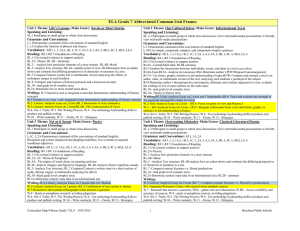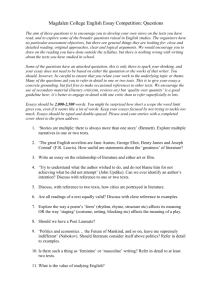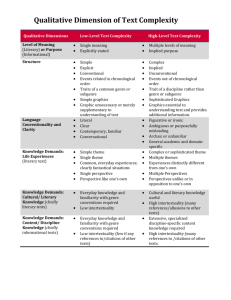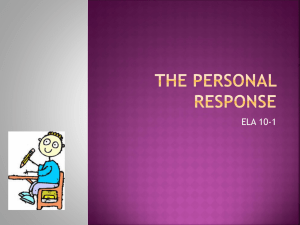ELA Grade 6 Brocton Curriculum Map
advertisement
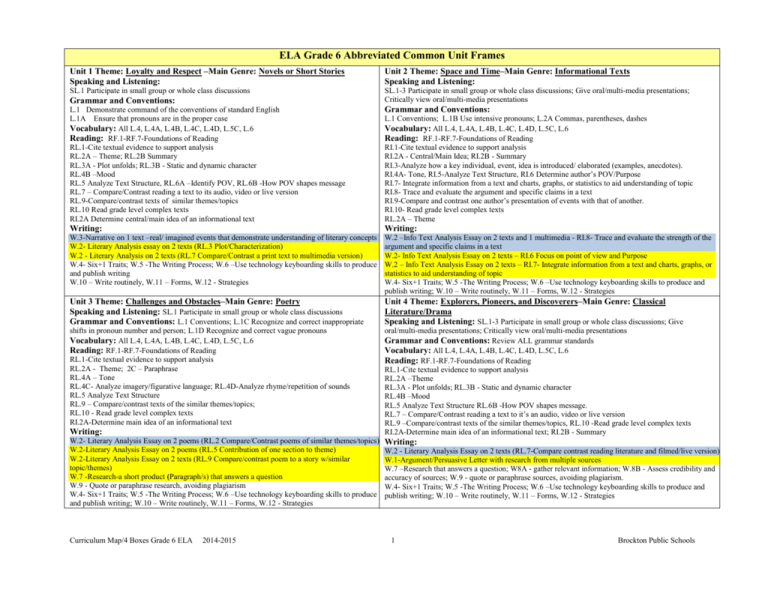
ELA Grade 6 Abbreviated Common Unit Frames Unit 1 Theme: Loyalty and Respect –Main Genre: Novels or Short Stories Speaking and Listening: Unit 2 Theme: Space and Time–Main Genre: Informational Texts Speaking and Listening: SL.1 Participate in small group or whole class discussions SL.1-3 Participate in small group or whole class discussions; Give oral/multi-media presentations; Critically view oral/multi-media presentations Grammar and Conventions: L.1 Demonstrate command of the conventions of standard English L.1A Ensure that pronouns are in the proper case Vocabulary: All L.4, L.4A, L.4B, L.4C, L.4D, L.5C, L.6 Reading: RF.1-RF.7-Foundations of Reading RL.1-Cite textual evidence to support analysis RL.2A – Theme; RL.2B Summary RL.3A - Plot unfolds; RL.3B - Static and dynamic character RL.4B –Mood RL.5 Analyze Text Structure, RL.6A –Identify POV, RL.6B -How POV shapes message RL.7 – Compare/Contrast reading a text to its audio, video or live version RL.9-Compare/contrast texts of similar themes/topics RL.10 Read grade level complex texts RI.2A Determine central/main idea of an informational text Grammar and Conventions: Writing: Writing: W.3-Narrative on 1 text –real/ imagined events that demonstrate understanding of literary concepts W.2- Literary Analysis essay on 2 texts (RL.3 Plot/Characterization) W.2 - Literary Analysis on 2 texts (RL.7 Compare/Contrast a print text to multimedia version) W.4- Six+1 Traits; W.5 -The Writing Process; W.6 –Use technology keyboarding skills to produce and publish writing W.10 – Write routinely, W.11 – Forms, W.12 - Strategies W.2 –Info Text Analysis Essay on 2 texts and 1 multimedia - RI.8- Trace and evaluate the strength of the argument and specific claims in a text W.2- Info Text Analysis Essay on 2 texts – RI.6 Focus on point of view and Purpose W.2 – Info Text Analysis Essay on 2 texts – RI.7- Integrate information from a text and charts, graphs, or statistics to aid understanding of topic W.4- Six+1 Traits; W.5 -The Writing Process; W.6 –Use technology keyboarding skills to produce and publish writing; W.10 – Write routinely, W.11 – Forms, W.12 - Strategies Unit 3 Theme: Challenges and Obstacles–Main Genre: Poetry Speaking and Listening: SL.1 Participate in small group or whole class discussions Grammar and Conventions: L.1 Conventions; L.1C Recognize and correct inappropriate Unit 4 Theme: Explorers, Pioneers, and Discoverers–Main Genre: Classical Literature/Drama Speaking and Listening: SL.1-3 Participate in small group or whole class discussions; Give shifts in pronoun number and person; L.1D Recognize and correct vague pronouns Vocabulary: All L.4, L.4A, L.4B, L.4C, L.4D, L.5C, L.6 Reading: RF.1-RF.7-Foundations of Reading RL.1-Cite textual evidence to support analysis RL.2A - Theme; 2C – Paraphrase RL.4A – Tone RL.4C- Analyze imagery/figurative language; RL.4D-Analyze rhyme/repetition of sounds RL.5 Analyze Text Structure RL.9 – Compare/contrast texts of the similar themes/topics; RL.10 - Read grade level complex texts RI.2A-Determine main idea of an informational text oral/multi-media presentations; Critically view oral/multi-media presentations Grammar and Conventions: Review ALL grammar standards Vocabulary: All L.4, L.4A, L.4B, L.4C, L.4D, L.5C, L.6 Reading: RF.1-RF.7-Foundations of Reading RL.1-Cite textual evidence to support analysis RL.2A –Theme RL.3A - Plot unfolds; RL.3B - Static and dynamic character RL.4B –Mood RL.5 Analyze Text Structure RL.6B -How POV shapes message. RL.7 – Compare/Contrast reading a text to it’s an audio, video or live version RL.9 –Compare/contrast texts of the similar themes/topics, RL.10 -Read grade level complex texts RI.2A-Determine main idea of an informational text; RI.2B - Summary Writing: W.2- Literary Analysis Essay on 2 poems (RL.2 Compare/Contrast poems of similar themes/topics) W.2-Literary Analysis Essay on 2 poems (RL.5 Contribution of one section to theme) W.2-Literary Analysis Essay on 2 texts (RL.9 Compare/contrast poem to a story w/similar topic/themes) W.7 -Research-a short product (Paragraph/s) that answers a question W.9 - Quote or paraphrase research, avoiding plagiarism W.4- Six+1 Traits; W.5 -The Writing Process; W.6 –Use technology keyboarding skills to produce and publish writing; W.10 – Write routinely, W.11 – Forms, W.12 - Strategies Curriculum Map/4 Boxes Grade 6 ELA 2014-2015 L.1 Conventions; L.1B Use intensive pronouns; L.2A Commas, parentheses, dashes Vocabulary: All L.4, L.4A, L.4B, L.4C, L.4D, L.5C, L.6 Reading: RF.1-RF.7-Foundations of Reading RI.1-Cite textual evidence to support analysis RI.2A - Central/Main Idea; RI.2B - Summary RI.3-Analyze how a key individual, event, idea is introduced/ elaborated (examples, anecdotes). RI.4A- Tone, RI.5-Analyze Text Structure, RI.6 Determine author’s POV/Purpose RI.7- Integrate information from a text and charts, graphs, or statistics to aid understanding of topic RI.8- Trace and evaluate the argument and specific claims in a text RI.9-Compare and contrast one author’s presentation of events with that of another. RI.10- Read grade level complex texts RL.2A – Theme Writing: W.2 - Literary Analysis Essay on 2 texts (RL.7-Compare contrast reading literature and filmed/live version) W.1-Argument/Persuasive Letter with research from multiple sources W.7 –Research that answers a question; W8A - gather relevant information; W.8B - Assess credibility and accuracy of sources; W.9 - quote or paraphrase sources, avoiding plagiarism. W.4- Six+1 Traits; W.5 -The Writing Process; W.6 –Use technology keyboarding skills to produce and publish writing; W.10 – Write routinely, W.11 – Forms, W.12 - Strategies 1 Brockton Public Schools

